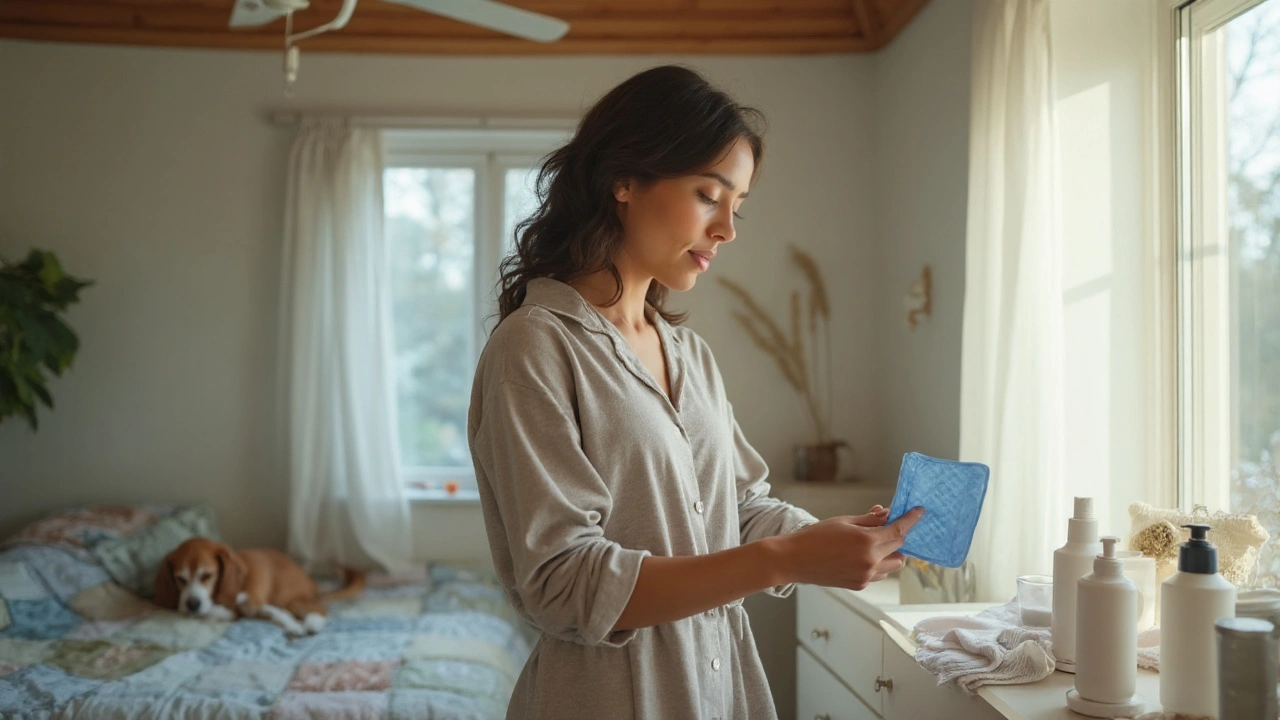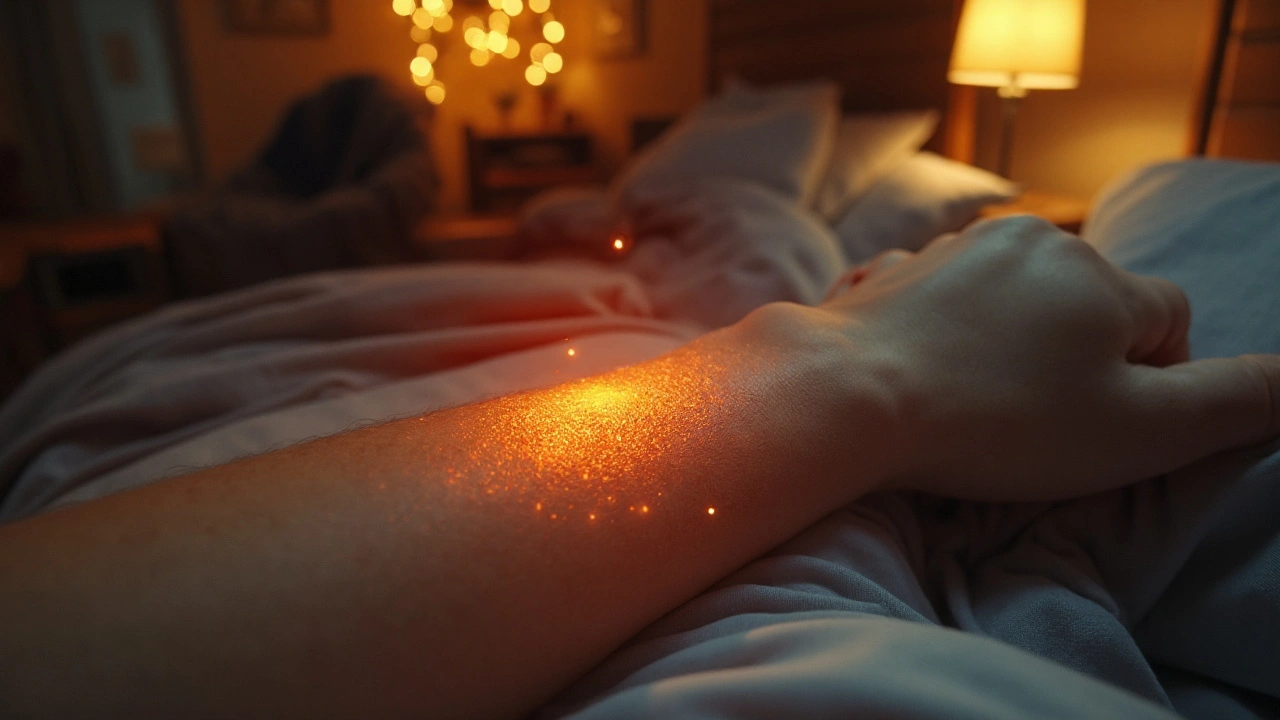
Your skin looks fine but feels sunburned. Or it itches like mad at 2 a.m. and you can’t find a rash. If fibromyalgia is on your chart, that mismatch makes sense. The nervous system turns the volume up on pain and touch, and the skin cops it. This guide breaks down what’s actually happening, how to tell fibro-related symptoms from true skin diseases, and the routines and treatments that help in real life. I live in Melbourne, where hot-cold flips and dry winter air make this worse, so I’ve learned the hard way how to manage flare days.
TL;DR: Rashes, Itching, and Skin Sensitivity in Fibromyalgia
- The skin issues are usually about nerves and inflammation, not an infection: burning, stinging, itch without rash, hives-like welts, and touch-pain (allodynia) are common.
- Rule of thumb: a visible, patterned rash that scales, weeps, or crusts needs a dermatology take; invisible burning/itching with normal-looking skin often points to fibro or nerve-related causes.
- What helps: short lukewarm showers, thick fragrance-free moisturiser, antihistamines for hives-y flares, neuropathic pain meds for burning itch, stress-sleep management, and trigger mapping.
- When to act fast: fever plus rash, rapidly spreading hives with breathing trouble, painful blisters, non-blanching purple spots, or new meds with sudden rash.
- Expect progress, not perfection. Track triggers for four weeks, adjust basics, and loop your GP if skin changes look “new” or severe.
Here’s the key idea: your fibromyalgia skin symptoms often come from sensitive nerves and overactive immune messengers in the skin, not from the skin “being diseased.” Treating the nerves, the barrier, and the triggers together works best.
What’s Actually Happening: Nerves, Mast Cells, and the Skin Barrier
Fibromyalgia lives in the nervous system, but your skin is wired straight into that network. When pain processing goes haywire, normal touch or temperature can trigger pain (allodynia) or an itchy, burning feel. Several research teams have found small-fiber nerve changes in a sizable chunk of people with fibromyalgia. Put simply, the tiny nerve endings in the skin can be fewer or crankier, which fits the burning and pins-and-needles story many of us tell. Systematic reviews over the last decade suggest up to half of people with fibromyalgia show some small fiber abnormalities on testing or biopsy. That’s not diagnostic by itself, but it explains why skin sensations are loud even when the skin looks normal.
There’s also the mast cell and histamine angle. Mast cells sit in your skin and release histamine and other chemicals that can cause flushing, itch, and hives-like welts. Studies in rheumatology and dermatology have linked mast-cell activation to symptom flares in fibromyalgia and other pain conditions. This is why non-sedating antihistamines, while not a cure, sometimes take the edge off the itch or the wheal-and-flare rashes that pop up without an obvious allergen.
Lastly, the barrier itself. Dry air, long hot showers, harsh cleansers, and Aussie spring winds can crack the outer skin layer, letting in irritants and turning up nerve firing. In Melbourne winters, I often get that tight, stingy face and “shirt hurts my shoulders” days after two back-to-back hot showers. When I switch to lukewarm showers under five minutes and use a rich, bland moisturiser right after, the sting dials down.
Key takeaways from the science:
- Sensory nerve amplification drives a lot of the skin discomfort. This is the same nervous system sensitivity that causes body-wide pain.
- Mast-cell and inflammatory signals can add itch, flushing, and hives-like outbreaks.
- Barrier damage makes everything worse-moisturising and gentle care matter far more than most of us think.
- Medications that calm nerve pain (like gabapentinoids or SNRIs) and simple skin strategies often help more than steroid creams unless there’s a true dermatologic disease.
Credible sources clinicians lean on for this picture include the American College of Rheumatology criteria for fibromyalgia, dermatology guidance from groups like the British Association of Dermatologists and the Australian College of Dermatologists, and reviews in journals such as Pain, Rheumatology, and Neurology discussing small-fiber changes and central sensitisation.

Spot the Pattern: Is It Fibro, Allergy, Eczema, or Something Else?
Not every itch is fibro, and not every rash is dangerous. The trick is pattern-spotting. Here’s a side-by-side to help you sort it out before you see your GP or dermatologist.
| Skin symptom | Clues it’s fibro-related | Clues it’s something else | First steps |
|---|---|---|---|
| Burning or stinging skin with normal appearance | Worse with light touch or tight clothes; no visible rash; common on shoulders, arms, thighs | Shingles pain follows a band and is often followed by blisters; contact dermatitis shows redness where product touched | Lukewarm showers, gentle cleansers, moisturise twice daily, consider neuropathic meds with GP |
| Itch with no rash | Worse at night; stress and temperature swings trigger; antihistamines partially help | Iron deficiency, thyroid issues, kidney/liver disease, scabies, or meds can cause itch too | Moisturise, consider non-sedating antihistamine, ask GP for basic bloods and medication review |
| Hives-like welts (urticaria) | Transient (fades in 1-24 hours), moves around, worse after heat or pressure | Fixed, persistent plaques or scaling point to eczema or psoriasis; infection can add fever | Non-sedating antihistamine, cool compresses; urgent care if swelling of lips/tongue or breathing trouble |
| Red, scaly, itchy patches in creases | Could be fibro overlapped with eczema (common in families with allergy) | Typical eczema pattern: behind knees, elbows, neck, eyelids; may crust or crack | Rich moisturiser, short showers; steroid cream short course per doctor; patch test products if recurrent |
| Purple spots that don’t blanch | Uncommon in fibro, think urgent | Could be vasculitis, platelet issues, or medication reaction | Seek urgent medical review today |
| Painful blisters | Not typical for fibro alone | Shingles, bullous disorders, severe drug reactions | Urgent care-do not wait |
Quick heuristics:
- If you can draw the exact border of a rash and it matches where a product touched, think irritant or allergic contact dermatitis.
- If the skin is “screaming” but looks normal, think nerve-driven (fibro, small fiber involvement, medication side effect).
- If pressing a red spot turns it white (blanches), it’s usually superficial; if it doesn’t blanch and looks purple, get same-day care.
- New medication + new rash within days to weeks? Call your prescriber. Duloxetine, pregabalin, and even supplements can cause rashes in some people.
Relief That Helps: Daily Routine, Triggers, and Evidence-Backed Treatments
This is the part you can control today. The combo approach-nerves + barrier + triggers-does the heavy lifting.
Daily skin routine (5 steps, 5-7 minutes):
- Shower smart: lukewarm, under 5 minutes. Hot water strips oils and boosts nerve firing.
- Cleanse gently: fragrance-free, pH-balanced wash; skip scrubs and loofahs.
- Pat, don’t rub: leave skin slightly damp.
- Seal the barrier: apply a thick, fragrance-free moisturiser or ointment within 2 minutes. Look for ceramides, glycerin, hyaluronic acid, petrolatum.
- Clothes count: soft, breathable fabrics; wash with dye-free, fragrance-free detergents.
Trigger checklist:
- Heat spikes (long hot showers, spas, Melbourne’s sudden warm northerlies)
- Pressure and friction (tight waistbands, backpacks on sore shoulders)
- Fragrance and alcohol-heavy skincare
- Stress, poor sleep, and hormonal swings
- New meds or supplements (note start dates)
What to use-and when:
- Moisturisers: daily, all year. In winter here, I switch to ointment at night. Eczema-prone skin loves thicker textures.
- Non-sedating antihistamines (cetirizine, fexofenadine, loratadine): handy for hives-like flares and itch. Pharmacists in Australia can guide dosing and interactions.
- Topical steroids: only if there’s a real inflamed rash (eczema, dermatitis). Use short courses, correct strength, and taper as advised by your doctor.
- Neuropathic itch/pain treatments: talk to your GP about duloxetine, pregabalin, or gabapentin if burning/itch dominates and skin looks normal. These are standard fibromyalgia options with skin benefits for some.
- Topicals for nerve pain: low-strength capsaicin can help desensitise nerve endings but can burn on first use; patch test a tiny area.
- Mind-body tools: paced breathing, warm packs, and gentle movement (like a slow walk by the Yarra) lower sympathetic arousal, which often eases itch and burning within minutes.
Low-risk extras some people find useful:
- Colloidal oatmeal baths for 10-15 minutes (not hot). Rinse lightly and moisturise straight after.
- Barrier-first makeup and skincare: mineral sunscreens and fragrance-free basics reduce flare risk compared with heavily scented products.
- Cooling gel packs for short bursts on hotspots-never directly on bare skin; wrap in a cloth.
What the evidence says (short version):
- Barrier repair (emollients) is consistently helpful for itch from dry/irritated skin across dermatology literature.
- Antihistamines work for urticaria/hives; they’re hit-or-miss for non-histaminic itch, but many fibro folks report partial relief, likely via mast-cell calming.
- Neuropathic agents (SNRIs, gabapentinoids) reduce pain and can cut neuropathic itch; these are core fibromyalgia meds backed by rheumatology guidelines.
- Stress-sleep interventions reduce central sensitisation and the perceived intensity of itch and allodynia.
Personal note: on flare weeks, my wife Juliet Harding can spot the “shirt hurts” look from across the room. My quick fix is a 4-minute lukewarm shower, ointment on shoulders and thighs, soft tee, then 10 minutes of box breathing. It doesn’t cure it, but it gets me functional again.
Product label decoder:
- “Fragrance-free” beats “unscented” (the latter can still include masking scents).
- “Soap-free” cleansers keep pH closer to skin’s natural range.
- For eczema overlap, look for ceramides; for very dry skin, petrolatum-based ointments seal better.
Common pitfalls:
- Chasing invisible itch with steroid creams. If there’s no rash, steroids won’t help much and can thin skin with overuse.
- Hot baths before bed. They feel good in the moment, then kick off a 2 a.m. itch-fest.
- Scrubbing or dry brushing “to improve circulation.” It often worsens allodynia.
- Too many actives at once (acids, retinoids, vitamin C) on sensitised skin.

Mini‑FAQ and Next Steps: When to Worry, Medications, and Troubleshooting
FAQ
- Is there a “fibromyalgia rash”? Not one single rash. Common patterns include hives-like welts, flushing, and normal-looking skin that feels on fire. True, named skin diseases (eczema, psoriasis, rosacea) can coexist and need their own treatment.
- Why does itch get worse at night? Core body temperature shifts, fewer distractions, and stress hormones unwinding can amplify nerve signals. A cooler room, cotton sleepwear, and moisturising 30 minutes before bed help.
- Are low-histamine diets worth it? Evidence is mixed. If you have frequent hives or flushing, a short, targeted trial with a dietitian can be reasonable. Don’t over-restrict without guidance.
- Do magnesium or omega-3s help the skin symptoms? They may help cramps or general inflammation for some, but they’re not skin-specific fixes. Keep expectations modest.
- Could this be small fiber neuropathy? Maybe. A pain specialist or neurologist can organise testing (like skin biopsy) if symptoms are severe or atypical. A positive test changes little day-to-day but can validate the nerve angle and guide therapy.
When to see a doctor promptly:
- Rash plus fever, joint swelling, or feeling very unwell
- Rapidly spreading hives with lip/tongue swelling or breathing changes-call emergency services
- Painful blisters, raw erosions, or widespread peeling skin
- Purple, non-blanching spots
- New medication in past 2-8 weeks with a new rash-contact your prescriber
When to book a routine GP or dermatology appointment:
- Persistent or recurring rashes (weeks)
- Itch that keeps you from sleeping
- Suspicion of eczema, psoriasis, or contact allergy
- Considering neuropathic medications or need a review of current meds
Troubleshooting different scenarios
- Invisible burning pain on shoulders and back: Switch to a creamy, fragrance-free cleanser; moisturise after every shower; try a cool pack for 10 minutes; ask your GP about duloxetine or pregabalin if it’s frequent.
- Hives after heat or pressure: Pre-empt with a non-sedating antihistamine before known triggers (exercise in hot weather), wear looser clothing, and cool down quickly after exertion.
- Itch that wakes you at 2 a.m.: Evening routine-5-minute lukewarm shower, thick moisturiser, cotton sleepwear, room at 18-20°C; consider sedating antihistamine only if advised by your doctor and safe for you.
- Red scaly patches in elbows/knees: Likely eczema overlap-stick to the barrier routine, apply a doctor-prescribed steroid cream for a short burst, then maintain with moisturisers and trigger avoidance.
- New rash after starting a supplement: Stop the new product and call your GP or pharmacist. Keep the bottle for review.
Four-week “skin calm” plan
- Week 1: Strip back. Use only a gentle cleanser and rich moisturiser. No fragrance, no scrubs, no new actives. Note shower time/temp and clothing choices.
- Week 2: Add a non-sedating antihistamine if hives-like flares occur. Track itch intensity at bedtime (0-10 scale).
- Week 3: If burning/tingling dominate, discuss a neuropathic agent trial with your GP. Keep moisturising routine.
- Week 4: Review your log. Identify three biggest triggers and set simple rules (example: showers under 5 minutes, switch detergents, loose waistbands).
Concerned about safety or interactions? Pharmacists can check for clashes with common fibromyalgia meds. Clinicians in Australia also keep an eye on PBS listings and cost-effective options-worth asking if price matters.
For credibility-minded readers: clinicians often reference the American College of Rheumatology fibromyalgia criteria, dermatology society guidance on urticaria and eczema management, and reviews over the last 5-10 years in Pain and Rheumatology journals that discuss small-fiber changes and central sensitisation. Your GP can translate those into a practical plan that fits your symptoms and history.
One last nudge: if your gut says “this rash is different,” trust that instinct and get it checked. Fibro can explain a lot, but not everything. The goal is simple-less itch, less sting, and more control of your day so you can get back to real life, whether that’s the school run in a Melbourne downpour or a quiet coffee on the balcony when the wind finally settles.




Alexis Hernandez
August 31, 2025Man, I used to think my skin was just 'sensitive' until I read this. Now I get why my t-shirts feel like sandpaper on bad days. No rash, just screaming nerves. I started using ceramide cream after showers and it’s like my skin finally stopped yelling. Still bad on hot days though. Melbourne weather is the real villain here.
Also, the 'shirt hurts' thing? Yeah. My wife calls it my 'fibro face'-like I just got slapped with a wet towel.
And yeah, hot showers are a trap. I thought they helped. They don’t. They just make the 2 a.m. itch worse. Learned that the hard way.
Now I keep a cool gel pack wrapped in a towel by the bed. Works better than anything else.
brajagopal debbarma
September 1, 2025So let me get this straight. You’re telling me 20 years of dermatologists were wrong and now it’s all just nerves? Cool story. Next you’ll say my acne is from bad vibes.
Meanwhile, I’ve got actual eczema that cracks and bleeds. You wanna call that a 'nervous system glitch'? Nah. I’ll take my steroid cream and my actual diagnosis, thanks.
Carly Smith
September 1, 2025Oh wow you actually wrote a whole guide about this
And you live in Melbourne so you’re an expert now
Like your shower routine is gospel
And you didn’t even mention that most people with fibro are broke and can’t afford ceramide creams
Or that antihistamines make you zombie
Or that your 'lukewarm shower' advice is useless if you’re living in a moldy apartment with no hot water
So congrats on your privilege tour
And yeah the skin looks fine but feels like it’s on fire
Because your life is fine but your body is not
And you’re still here writing paragraphs
While I’m scratching my legs raw on a 2 a.m. couch
Good job
Love the vibe
Kurt Stallings
September 3, 2025Central sensitization. Mast cell activation. Small fiber neuropathy.
Three terms. That’s all you need.
The rest is fluff.
Moisturizer is not treatment.
It’s placebo with a label.
And yes, I’ve read the journals.
You haven’t.
But you wrote a blog.
So you’re the expert.
Got it.
Angie Creed
September 4, 2025Let me just say this: the fact that we’re even having this conversation is a symptom of a broken medical system.
Why are we treating symptoms instead of asking why the nervous system is screaming in the first place?
Why are we giving people antihistamines and ceramides when the real issue is trauma, toxicity, and the slow death of our connection to nature?
My skin burned for years before I realized it wasn’t my skin-it was my soul screaming for silence.
You can’t moisturize your way out of a life lived in fight-or-flight.
And if you think a 5-minute shower fixes that, you’re missing the point.
Big picture.
It’s all connected.
And nobody’s talking about it.
Except me.
And now you are.
Thank you.
Now go sit in the woods for a week.
And come back when you’re ready to heal, not just manage.
Michael Ferguson
September 6, 2025Look, I’ve been living with this for 14 years and I’ve tried everything. I’ve done the hot showers, the antihistamines, the gabapentin, the coconut oil, the oatmeal baths, the CBD creams, the magnesium, the elimination diets, the yoga, the breathwork, the cryotherapy, the acupuncture, the chiropractor, the neurofeedback, the essential oils, the crystal healing, the Reiki, the sound baths, the float tanks, the grounding mats, the red light therapy, the infrared sauna, the cold plunge, the meditation apps, the journaling, the EMDR, the therapy, the trauma work, the EFT tapping, the kundalini, the shamanic journeying, the plant medicine, the ayahuasca retreat, the fasting, the keto, the vegan, the carnivore, the paleo, the low histamine, the low oxalate, the low FODMAP, the gluten-free, the dairy-free, the soy-free, the nightshade-free, the sugar-free, the salt-free, the caffeine-free, the alcohol-free, the screen-free, the phone-free, the social-media-free, the Netflix-free, the music-free, the silence, the silence, the silence-and still, at 2 a.m., my skin feels like it’s been dipped in acid and then rubbed with sandpaper.
So when someone says 'lukewarm shower and moisturizer' like it’s the answer, I want to scream.
It’s not the answer.
It’s a Band-Aid on a hemorrhage.
And the system that lets this happen is broken.
And I’m tired.
And I’m angry.
And I’m still here.
And I’m still scratching.
And I’m still waiting.
For what?
I don’t even know anymore.
But I’ll keep trying.
Because what else is there?
Patrick Klepek
September 7, 2025Honestly? I think this is one of the most practical, grounded takes I’ve seen on fibro skin stuff.
Not the 'heal your trauma' nonsense.
Not the 'just use this cream' fluff.
But real, actionable stuff-like the shower time, the moisturizer window, the trigger log.
And the part about mast cells? Yeah, that’s real. I’ve had hives pop up after a warm shower with zero allergens. It’s weird. It’s real.
Also, the 'shirt hurts' thing? My partner calls it 'fibro mode' when I stop moving and just stare at the wall like a confused raccoon.
Anyway. Thanks for writing this. I’m printing it out.
And yeah, Melbourne winters are brutal. I feel you.
Sebastian Brice
September 8, 2025I just wanted to say I appreciate this. I’ve been avoiding dermatologists because I didn’t want to be told 'it’s all in your head'-but this actually acknowledges the head AND the skin.
And the part about antihistamines being hit-or-miss? That’s so true. I tried cetirizine and it did nothing. Then I tried loratadine and it cut the nighttime itching by half. No idea why.
Also, the clothing thing? Huge. I switched to bamboo tees and it’s like my skin finally took a breath.
Still have bad days. Still wake up screaming. But now I have a plan. And that’s more than I had last year.
Thanks for sharing your truth.
It helps.
Jim Aondongu
September 8, 2025People in Nigeria have fibromyalgia too you know
But we dont have ceramide creams or lukewarm showers
Some of us dont even have clean water
And you write all this like its a lifestyle blog
But for me the itch is just part of life
Like hunger
Like pain
Like silence
So thank you for your advice
But not everyone can afford to be gentle
Some of us just have to survive
And still we are here
Still we feel
Still we itch
And still we write
Because someone has to say it
Even if no one listens
Michael Schaller
September 10, 2025I’ve had this for 8 years. I didn’t know it was fibro until last year. The skin burning? I thought I was allergic to everything. Turns out, it’s just my nerves on fire. I started using Vanicream and it changed everything. No more redness, no more raw patches. Just… quieter skin.
And the 2 a.m. itch? I started sleeping with a fan. Cold air helps. Weird, right?
Also, I stopped wearing cotton. Too rough. Now it’s all bamboo or silk. Feels like a hug.
Still not perfect. But better.
And I finally stopped blaming myself.
Kyle Tampier
September 10, 2025THIS IS A GOVERNMENT COVER-UP. THE CDC KNOWS FIBROMYALGIA IS CAUSED BY 5G RADIATION AND FLUORIDATED WATER. THE PHARMA COMPANIES ARE SELLING YOU CERAMIDES TO KEEP YOU QUIET WHILE THEY INJECT YOU WITH MICROCHIPS THROUGH YOUR SKIN. THEY WANT YOU TO THINK IT’S 'NERVE SENSITIVITY' SO YOU WON’T ASK WHY YOUR MIND IS BEING HACKED. I’VE MET PEOPLE WHO REMEMBERED THE TRUTH AFTER A CRYSTAL CLEANSE. THEY SAID THE SKIN BURNING WAS THE BODY’S ATTEMPT TO EXPEL THE NANOBOTS. YOU’RE BEING MANIPULATED. CHECK YOUR CLOTHING TAGS. IF IT SAYS 'POLYESTER,' YOU’RE BEING TARGETED. I’M NOT CRAZY. I’M AWAKE. AND I’M WATCHING YOU.
Tom Caruana
September 11, 2025OMG I FEEL YOU SO MUCH 😭 I WAS JUST SCRATCHING MY ARMS SO HARD LAST NIGHT AND MY HUSBAND SAID 'WHY DO YOU DO THIS TO YOURSELF' AND I JUST CRIED BECAUSE I DIDN’T KNOW EITHER 😭 BUT THEN I READ THIS AND I WAS LIKE OH MY GOD IT’S NOT JUST ME I’M NOT CRAZY 🥹 I STARTED USING THE CERAMIDE CREAM AND IT’S LIKE A MIRACLE 🙏 BUT STILL THE 2AM ITCH 😭 I’M SLEEPING WITH A COLD WASHCLOTH ON MY NECK NOW 🥶 AND I JUST WANT TO HUG EVERYONE WHO GETS THIS 😭 WE’RE NOT ALONE 💙💛💚
Muzzafar Magray
September 12, 2025This is not medicine. This is self-help theater. Fibromyalgia is not a skin condition. It is a failure of the body to adapt to modern life. The real problem is not your moisturizer. It is your lifestyle. You sit too much. You eat too much sugar. You sleep too late. You stress too much. You have no discipline. The skin is just the messenger. Fix your life. Not your cream. Stop treating symptoms. Start treating causes. Or keep scratching. Either way, you are not getting better.
Renee Williamson
September 12, 2025Okay but what if it’s not fibro at all? What if it’s the EMF from the smart meter outside my window? Or the glyphosate in my tap water? Or the fact that my ex left me and my body is still in trauma mode? I’ve been having these burning episodes since I moved into this apartment and I’m 100% sure it’s the Wi-Fi router. I took a picture of my skin with my phone and the redness glows under UV light. I showed my dermatologist and she laughed. LAUGHED. Like I’m crazy. But I’m not. I’m just the only one who sees the truth. I’ve started sleeping in a Faraday cage. It’s not pretty. But I’m alive. And my skin? It’s… quieter. Barely. But quieter. And I’m not sorry. I’m not sorry I’m not normal. I’m not sorry I’m not quiet. I’m not sorry I’m not healing the way you want me to. I’m healing MY way. And if that means wrapping myself in aluminum foil and whispering to my crystals? Then so be it. I’m not broken. I’m just… too sensitive for this world.
Manish Mehta
September 14, 2025I’ve been dealing with this for years. I didn’t know what it was. Just thought I was weird. Skin feels like it’s on fire but looks fine. Then I read this. It made sense. I started the shower routine. Used the moisturizer right after. Didn’t change my life. But made the bad days… bearable. Not perfect. But better. And that’s enough for now. Thanks for writing this. I needed to hear it.
Okechukwu Uchechukwu
September 15, 2025Let’s be honest: this is just another example of medicalization of normal human discomfort. The skin has always been sensitive. The body has always reacted to stress. But now we need a label, a protocol, a cream, a journal, a 4-week plan. We’ve turned suffering into a product. You didn’t cure anything. You just gave people a shopping list. And now they’re spending money on ceramides instead of asking why their lives are so exhausting. The real issue isn’t your skin. It’s your schedule. Your anxiety. Your isolation. Your lack of meaning. But that’s harder to fix than a moisturizer. So we sell you lotion. And you buy it. And we all pretend it’s healing. It’s not. It’s just distraction with a label.
Sarah Cline
September 16, 2025Y’all I just want to say - YOU’RE NOT ALONE. I’ve been there. The 2 a.m. itch. The shirt that feels like barbed wire. The shame of explaining why I can’t wear jeans. I used to hide my arms. Now I wear short sleeves and say ‘yeah, fibro skin’ like it’s a badge. And guess what? People get it. They say ‘oh my gosh, my mom has that too.’
And you know what helps even more? Telling someone. Just one person. It’s not weakness. It’s connection.
So if you’re reading this and you’re scratching right now - I see you. I’m right here with you. Let’s keep going. One lukewarm shower at a time. 💪💖